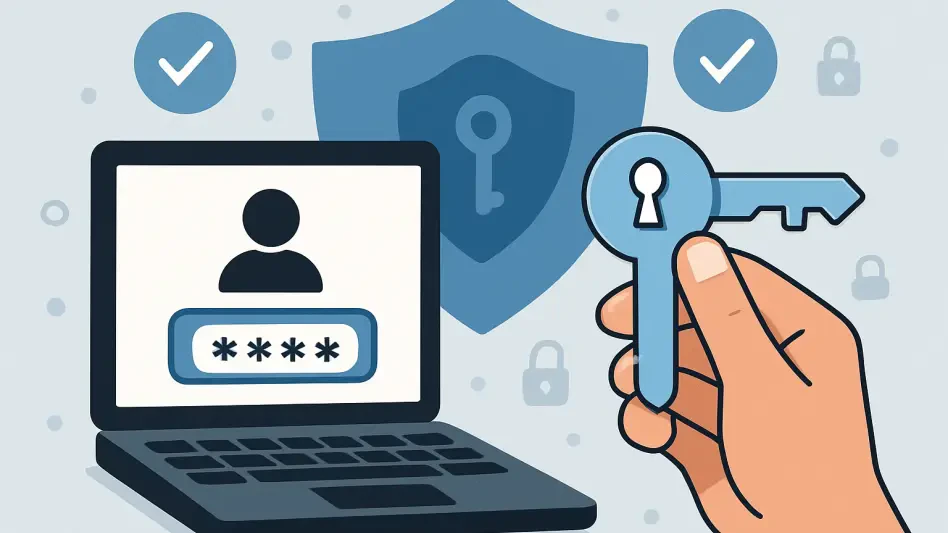In an era where digital security breaches seem to dominate headlines, the average individual grapples with managing over 100 unique passwords for everything from banking apps to streaming services, creating a daunting challenge that often leads to risky habits like password reuse. This overwhelming burden not only frustrates users but also exposes them to significant cybersecurity threats, as hackers exploit these vulnerabilities with alarming ease. The concept of passkeys has emerged as a promising solution, heralding a potential end to the password era with a method that prioritizes both security and simplicity. Unlike traditional login credentials, passkeys leverage advanced encryption and biometric data to authenticate users without ever sharing sensitive information. As cyber threats grow more sophisticated, exploring alternatives to outdated password systems becomes imperative. This discussion delves into how passkeys could redefine online authentication, addressing long-standing security gaps while navigating the hurdles of widespread adoption in a rapidly evolving digital landscape.
Understanding the Mechanics of Passkeys
The foundation of passkeys lies in a revolutionary approach to authentication that moves beyond the conventional username-password model, instead utilizing a digital key securely stored on a user’s device. This key, paired with biometric data such as fingerprints or facial recognition, or even a simple PIN, ensures that access is granted only to the rightful owner. What sets passkeys apart is their reliance on public key cryptography, a method that prevents sensitive credentials from being transmitted between the device and the website. This design drastically reduces the risk of interception by malicious actors. Furthermore, passkeys are uniquely tied to specific platforms, rendering them useless on fraudulent sites and offering robust protection against phishing attacks. As a result, the likelihood of unauthorized access diminishes significantly, positioning this technology as a formidable barrier against common cyber threats that have long plagued password-based systems.
Delving deeper into their functionality, passkeys eliminate the need for centralized storage of login information, a frequent target for large-scale data breaches. Unlike passwords, which are often stored in vulnerable databases, passkeys remain on the user’s device, ensuring that even if a server is compromised, there’s no credential to steal. Cybersecurity experts highlight that this localized approach addresses a critical flaw in traditional systems, where a single breach can expose millions of accounts. Additionally, the seamless integration of passkeys with existing devices means users don’t need to overhaul their tech setup to adopt this method. However, challenges remain, such as ensuring compatibility across diverse platforms and educating users about this shift. Despite these hurdles, the underlying technology signals a transformative step toward a more secure digital environment, potentially reshaping how authentication is perceived and implemented.
Comparing Passkeys to Existing Security Measures
When placed alongside two-factor authentication (2FA), passkeys reveal a distinct advantage by completely bypassing the need for passwords rather than merely supplementing them with an additional verification step. While 2FA enhances security by requiring a secondary method—like a code sent to a phone—it still relies on a primary password that can be vulnerable to theft or reuse. Passkeys, on the other hand, embed multifactor authentication directly into their framework, combining something the user has (the device) with something they are (biometric data). This inherent dual-layer protection tackles multiple security needs in one streamlined process. Experts in the field argue that this integration not only simplifies the login experience but also closes gaps that 2FA cannot fully address, especially in scenarios where passwords are compromised through social engineering or phishing tactics.
Beyond their comparison with 2FA, passkeys also stand out for their user-centric design, which contrasts sharply with the often cumbersome nature of traditional security measures. With passwords, users frequently face the frustration of resets or the temptation to use easily guessable combinations, undermining overall safety. Passkeys mitigate these issues by automating much of the authentication process, reducing human error and the cognitive load of remembering complex strings of characters. Yet, adoption is not without obstacles, as compatibility issues persist on older devices or less-supported platforms. There’s also the concern of account recovery if a device linked to a passkey is lost or damaged. Despite these limitations, the shift toward passkeys represents a forward-thinking approach that could eventually render many current security protocols obsolete, provided the technology matures and gains broader acceptance across industries.
Navigating the Path to Widespread Adoption
As passkeys gain attention as a viable alternative to passwords, their journey toward universal adoption reveals both promise and significant challenges that must be addressed over the coming years. The primary appeal lies in their ability to enhance security while simplifying the user experience, a balance that has eluded password systems for decades. By eliminating the need to store or recall complex credentials, passkeys offer a glimpse into a future where logging in is as intuitive as unlocking a smartphone. However, their current reach is limited, with not all services or devices supporting this technology. This patchwork implementation creates friction for users who operate across multiple ecosystems. Bridging this gap requires coordinated efforts from tech giants, developers, and service providers to standardize protocols and ensure seamless integration, a process that will likely unfold gradually over time.
Reflecting on the road ahead, the successful rollout of passkeys hinges on overcoming user skepticism and technical barriers that surfaced during early implementations. Concerns about losing access to accounts if a device fails or is stolen remain valid, necessitating robust recovery mechanisms that maintain security without sacrificing convenience. Additionally, educating the public about the benefits and functionality of passkeys proved essential in past pilot programs, as unfamiliarity often bred reluctance. Industry stakeholders must prioritize clear communication and accessible support to ease this transition. Looking back, efforts to bolster cybersecurity through passkeys demonstrated a pivotal shift in addressing digital vulnerabilities. The next steps involve refining these systems, expanding compatibility, and fostering trust, ensuring that this innovative authentication method evolves into a cornerstone of online safety for users worldwide.








